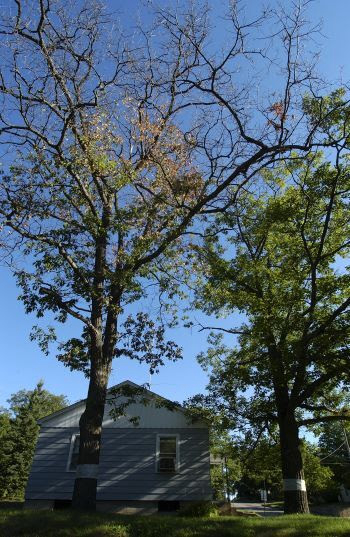
|
Oak wilt infections have been confirmed in two stands of trees in southwest Marquette County, signaling additional spread of the often-fatal oak tree fungus in Michigan's Upper Peninsula.
Additional areas of dead or dying oak, known as “mortality pockets,” may also be in the area; however, not all dead or dying oak is the result of oak wilt infection.
Oak wilt is a tree disease caused by the fungus Bretziella fagacearum. It spreads from tree to tree by underground root contact or through tiny, sap-feeding beetles that carry spores from fungal pads on infected trees to wounds on healthy oaks.
The fungus can kill red oaks within weeks, while white oaks are better able to withstand the disease.
“If you have oak trees, it is important to be aware of the symptoms of this disease and report them if you see them,” said Simeon Wright, forest health specialist with the Michigan Department of Natural Resources.
Oak wilt symptoms are most noticeable from late June through September. Affected red oak trees may rapidly shed leaves from the top down. Leaves may be green, brown or a combination of both colors. Affected trees typically appear dead within weeks of symptom development, well before natural leaf drop. Trees that die more slowly or hold onto most of the dead leaves probably died from other causes.
“Unfortunately, the mortality pockets confirmed in Marquette County suggest oak wilt has been present for several years,” Wright said. The DNR's oak wilt viewer offers a map showing the approximate location of these mortality pockets.
The new identification in Marquette County is about 25 miles from the closest previously known infections in southern Iron County and is the farthest one east of the Wisconsin border. Oak trees are limited in number between areas of previously known infection and the new location, suggesting that movement of firewood – not natural spread across the landscape – may be responsible for the spread.
Oak wilt is fairly widespread in the Lower Peninsula. In the Upper Peninsula, it was first detected in Menominee County in 1981, and until now detection has mostly been limited to areas near the Wisconsin border in Menominee, Dickinson and Iron counties.
“This is a reminder that oak wilt is still moving into new areas, and this follows reports of expansion of the disease into northern Minnesota and Wisconsin,” Wright said.
Because there is no cure for oak wilt, prevention is the goal. Precautions you can take include:
If you suspect a tree has oak wilt
Trees killed by oak wilt require special management. If you suspect a tree has died of oak wilt, you can help slow the spread by burning it on-site, chipping it or debarking it before April 15. Once the wood has been dried for longer than a year and/or all the bark loosens, the firewood can no longer spread oak wilt.